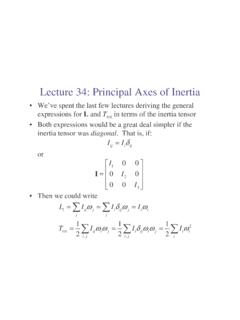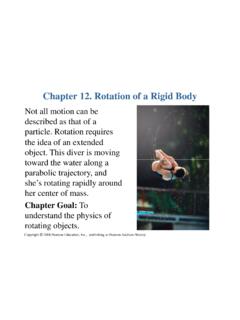Transcription of 3D Rigid Body Dynamics: The Inertia Tensor
1 J. Peraire, S. Widnall Dynamics Fall 2008. Version Lecture L26 - 3D Rigid Body Dynamics: The Inertia Tensor In this lecture, we will derive an expression for the angular momentum of a 3D Rigid body. We shall see that this introduces the concept of the Inertia Tensor . Angular Momentum We start from the expression of the angular momentum of a system of particles about the center of mass, H G , derived in lecture L11, n n . HG = (r i mi ( r i )) = mi ri 2 (1). i=1 i=1. n n . HG = (r i mi ( r i )) = mi ri 2 = r v dm (2).
2 I=1 i=1 m . HG = r v dm . m Here, r is the position vector relative to the center of mass, v is the velocity relative to the center of mass. We note that, in the above expression, an integral is used instead of a summation, since we are now dealing with a continuum distribution of mass. For a 3D Rigid body, the distance between any particle and the center of mass will remain constant, and the particle velocity, relative to the center of mass, will be given by v = r . 1. Thus, we have, . HG = r ( r ) dm = [(r r ) (r )r ] dm.
3 M m Here, we have used the vector identity A (B C) = (A C)B (A B)C. We note that, for planar bodies undergoing a 2D motion in its own plane, r is perpendicular to , and the term (r ) is zero. In this case, the vectors and H G are always parallel. In the three-dimensional case however, this simpli cation does not occur, and as a consequence, the angular velocity vector, , and the angular momentum vector, H G , are in general, not parallel. In cartesian coordinates, we have, r = x i + y j + z k and = x i + y j + z k, and the above expression can be expanded to yield.
4 2 2 2 . HG = x (x + y + z ) dm . ( x x + y y + z z )x dm i m m . 2 2 2 . + y (x + y + z ) dm ( x x + y y + z z )y dm j m . m . 2 2 2 . + z (x + y + z ) dm ( x x + y y + z z )z dm k m m = ( Ixx x Ixy y Ixz z ) i + ( Iyx x + Iyy y Iyz z ) j + ( Izx x Izy y + Izz z ) k . (3). The quantities Ixx , Iyy , and Izz are called moments of Inertia with respect to the x, y and z axis, respectively, and are given by . Ixx = (y 2 + z 2 ) dm , Iyy = (x 2 + z 2 ) dm , Izz = (x 2 + y 2 ) dm . m m m We observe that the quantity in the integrand is precisely the square of the distance to the x, y and z axis, respectively.
5 They are analogous to the moment of Inertia used in the two dimensional case. It is also clear, from their expressions, that the moments of Inertia are always positive. The quantities Ixy , Ixz , Iyx , Iyz , Izx and Izy are called products of Inertia . They can be positive, negative, or zero, and are given by, . Ixy = Iyx = x y dm , Ixz = Izx = x z dm , Iyz = Izy = y z dm . m m m They are a measure of the imbalance in the mass distribution. If we are interested in calculating the angular momentum with respect to a xed point O then, the resulting expression would be, HO = ( (Ixx )O x (Ixy )O y (Ixz )O z ) i + ( (Iyx )O x + (Iyy )O y (Iyz )O z ) j + ( (Izx )O x (Izy )O y + (Izz )O z ) k.
6 (4). 2. Here, the moments of products of Inertia have expressions which are analogous to those given above but with x , y and z replaced by x, y and z. Thus, we have that . (Ixx )O = (y 2 + z 2 ) dm , (Iyy )O = (x2 + z 2 ) dm , (Izz )O = (x2 + y 2 ) dm , m m m and, . (Ixy )O = (Iyx )O = xy dm , (Ixz )O = (Izx )O = xz dm , (Iyz )O = (Izy )O = yz dm . m m m The Tensor of Inertia The expression for angular momentum given by equation (3), can be written in matrix form as, . HGx Ixx Ixy Ixz x . = Iyx Iyz y.
7 (5).. HGy Iyy . HGz Izx Izy Izz z or, H G = [IG ] , (6). where [IG ] is the Tensor of Inertia (written in matrix form) about the center of mass G and with respect to the xyz axes. The Tensor of Inertia gives us an idea about how the mass is distributed in a Rigid body. Analogously, we can de ne the Tensor of Inertia about point O, by writing equation(4) in matrix form. Thus, we have H O = [IO ] , where the components of [IO ] are the moments and products of Inertia about point O given above. It follows from the de nition of the products of Inertia , that the tensors of Inertia are always symmetric.
8 The implications of equation (5) are that in many situations of importance, even for bodes of some symmetry, the and the angular velocity vector . angular momentum vector H are not parallel. This introduces considerable complexity into the analysis of the dynamics of rotating bodies in three dimensions. 3. Principal Axes of Inertia For a general three-dimensional body, it is always possible to nd 3 mutually orthogonal axis (an x, y, z coordinate system) for which the products of Inertia are zero, and the Inertia matrix takes a diagonal form.
9 In most problems, this would be the preferred system in which to formulate a problem. For a rotation about only one of these axis, the angular momentum vector is parallel to the angular velocity vector. For symmetric bodies, it may be obvious which axis are principle axis. However, for an irregular-shaped body this coordinate system may be di cult to determine by inspection; we will present a general method to determine these axes in the next section. But, if the body has symmetries with respect to some of the axis, then some of the products of Inertia become zero and we can identify the principal axes.
10 For instance, if the body is symmetric with respect to the plane x = 0 then, we will have Ix y = Iy x = Ix z = Iz x = 0 and x will be a principal axis. This can be shown by looking at the de nition of the products of Inertia . The integral for, say, Ix y can be decomposed into two integrals for the two halves of the body at either side of the plane x = 0. The integrand on one half, x y , will be equal in magnitude and opposite in sign to the integrand on the other half (because x will change sign).















